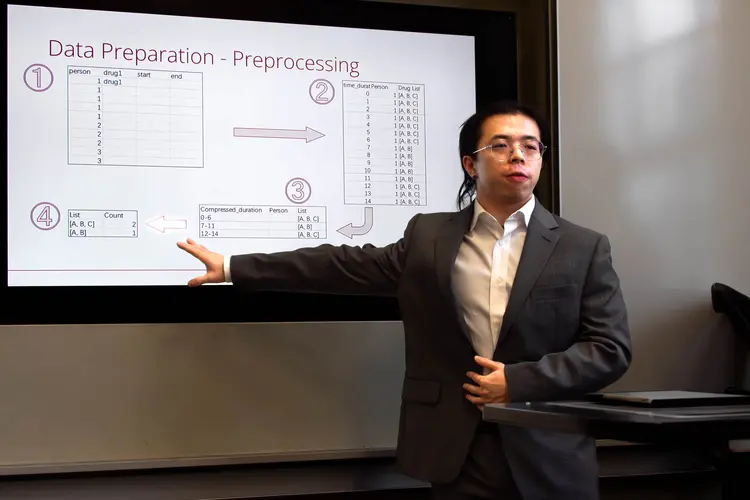
Researchers Urge Shift To Social Context in Alcohol Studies
Media Inquiries
A recent editorial(opens in new window) by researchers at Carnegie Mellon University's Dietrich College of Humanities and Social Sciences(opens in new window) and the University of Illinois Urbana-Champaign calls for a significant change in how laboratory alcohol studies are conducted. Published in the journal Addiction, the editorial emphasizes the urgent need for experimental research that incorporates social drinking contexts to more accurately reflect typical alcohol consumption and better understand the development of alcohol use disorders (AUD).
"Drinking is inherently a social activity for most people," said Kasey G. Creswell(opens in new window), associate professor of psychology at Dietrich College. "By studying alcohol's effects in isolation, we're missing crucial insights into how alcohol affects social interactions, as well as how social interactions influence drinking behavior and the risk of developing AUD."
Since the 1930s, laboratory alcohol administration studies have primarily focused on individual participants consuming alcohol in isolation. A systematic review conducted by Creswell and Catharine E. Fairbairn, a Helen Corley Petit Associate Professor of Psychology at Urbana, revealed that out of 989 published studies, 90.8% had participants drink alone. This is in contrast to real-world scenarios where the majority of alcohol consumption occurs in social settings.
The editorial highlights that social drinking contexts are prevalent across all age groups and levels of alcohol use. For example, 86% of drinking occasions among over 60,000 British adults occurred in social settings. Similarly, U.S. high school seniors reported that 75.5% of past-year drinking happened at parties, with many citing social motives for their alcohol use.
"Alcohol's ability to enhance social bonding and reduce social tension is a key factor in its widespread use," Creswell said. "Understanding these social reinforcement mechanisms is important for understanding AUD risk and perhaps improving prevention efforts."
The authors also point out methodological limitations in the small percentage of studies that do incorporate social contexts. Many of these studies underpowered (the sample sizes were too small) and fail to account for the interdependent nature of social interactions in their analyses.
"Advanced statistical methods that consider the reciprocal influence of group members are essential," Fairbairn said. "Without them, we risk drawing inaccurate conclusions that could hinder our efforts to address alcohol-related harms."
Creswell and Fairbairn advocate for well-powered, multiparticipant studies that utilize appropriate analytical techniques. Such research has already shown promise in revealing how alcohol affects emotions and social reward dynamics in group settings.
"Investing in socially contextualized alcohol research is not just about academic curiosity," Creswell said. "It's an important step toward addressing the public health challenges posed by alcohol misuse and AUD."
New Study Investigates Alcohol Use and Relationships
In alignment with the focus of the editorial, Creswell was recently awarded a $3 million grant from the National Institute on Alcohol Abuse and Alcoholism (NIAAA) for a project titled "Close Relationships and Alcohol Use Disorder Risk." This five-year study aims to understand how lower relationship quality (RQ) impacts alcohol use and the development of alcohol use disorders. Fairbairn is a co-investigator on this project, along with Brooke Feeney, a professor of psychology at Dietrich College.
While lower RQ — such as partner conflict, relationship dissatisfaction and insecure attachment — has been linked to the development of AUD and relapse after treatment, the specific mechanisms behind this connection remain unclear. Creswell’s new research seeks to fill this gap by investigating how couples with lower RQ experience alcohol differently, potentially leading to heavier consumption and increased risk of AUD.
"Individuals often report that relationship problems contribute significantly to their excessive alcohol use," Creswell said. "Our study will explore whether alcohol provides more social and emotional reinforcement for couples with lower relationship quality, which could set them on a path toward problematic drinking."
The research involves multiple disciplines and methods, incorporating best practices from social psychology to comprehensively understand interpersonal processes, as well as a laboratory alcohol administration paradigm with surveys completed in daily life and longer-term follow-up across 12 months.
According to Fairbairn, targeting alcohol reinforcement within couples, both in the lab and real-life contexts, may have wide-ranging implications that could inform prevention efforts and lead to more effective, tailored interventions for couples struggling with AUD.
"Advancing our understanding of alcohol use and its associated harms requires that we study alcohol in the contexts where it is most often consumed," Creswell said. "Our goal is to bridge the gap between laboratory research and real-world drinking behaviors to develop more effective solutions for AUD."
Creswell was joined by Catharine E. Fairbairn, University of Illinois at Urbana-Champaign, in the editorial titled “The Need for Multi-Participant Alcohol Administration Studies.” Research for the editorial was supported by the National Institutes of Health. The NIAA grant is titled “Close Relationships and Alcohol Use Disorder Risk.”



